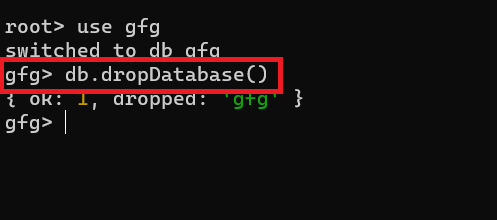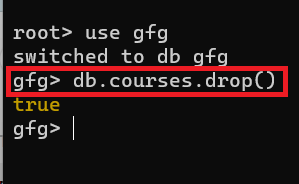How to Delete Everything in a MongoDB Database?
Last Updated :
26 Apr, 2024
In MongoDB, Deleting everything in the database is the most preventive task. These operations are irreversible, and all data, collections, indexes, and even the database itself will be permanently deleted.
In this article, we’ll explore different approaches to deleting all data in a MongoDB database from deleting individual collections to dropping the entire database.
How to Delete Everything in MongoDB Database
When it comes to MongoDB, deleting all data can be solved in several ways. Below are the approaches that can help us to delete everything in different ways as follows:
- Using dropDatabase()
- Using drop()
- Using deleteMany({})
1. Using dropDatabase()
In MongoDB, dropDatabase method is used to drop the currently selected database, it can delete all collections, indexed, and data. If you use this, you can’t reverse the data Make sure you have backed up your data before dropping a database.
Syntax:
db.dropDatabase()
- db: current database connection.
- dropDatabase(): method that drops (deletes) the currently selected database.
Example: Delete the Entire GFG Database
Query:
use gfg
db.dropDatabase()
Output:

The above query initially switches to the database named called “gfg” using the use command, and it executes the db.dropDatabase() method to drop (delete) the entire “gfg” database, including all its collections, indexes, and data.
2. Using drop()
In MongoDB, the drop method is used to delete a particular collection from the database. If you use this, you can’t reverse the data drop method permanently deletes the collection or index and its data.
Syntax:
db.collection.drop()
- db: The database object.
- collection: The name of the collection you want to drop.
Example: Delete the Entire Courses Collection
Query:
use gfg
db.courses.drop().
Output:

The above query initially switches to the database named called “gfg” using the use command, and it executes the db.courses.drop() method to drop the collection named “courses” from the “gfg” database, permanently removing all its documents and indexes
3. Using deleteMany()
In the MongoDB, deleteMany method is used to delete multiple documents from the collection that match the given filter criteria. If you use this, you can’t reverse the data deleteMany method permanently deletes the documents from the collection.
Syntax:
db.collection.deleteMany(filter)
- db: The database object.
- collection: The name of the collection from which you want to delete documents.
- filter: A filter object that specifies the documents to delete.
Example: Delete the Tithe Field in Courses in Collection
Query:
use gfg
db.courses.deleteMany({ Title: "Java" })
Output:
1.png)
The above query initially switches to the “gfg” database using the use command, and then executes the db.courses.deleteMany({ Title: “Java” }) method to delete all documents from the “courses” collection where the “Title” field has the value “Java”.
Conclusion
Overall summary, the drop method is used to delete only collections. To drop the entire database you can use dropDatabase method. and deleteMany method does not automatically drop the collection. When you truly want to delete and remove the entire database and start new database then use the above methods, it cannot be can’t reverse the data.
Share your thoughts in the comments
Please Login to comment...